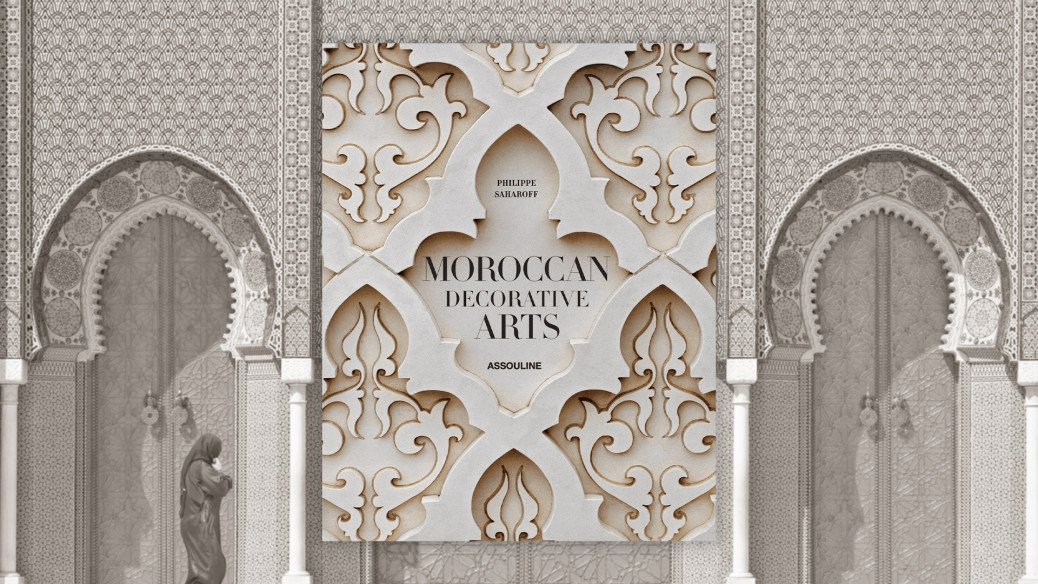Philippe Saharoff’s photography showcases Moroccan decorative arts, including zellige, pottery, metalwork, and exclusive photographs of King Mohammed VI’s collection as the ultimate tribute to Moroccan cultural heritage and craftsmanship.
The newly-released Moroccan Decorative Arts (published on Assouline) is a visually evocative exploration of the country’s rich artisan traditions by Philippe Saharoff, a photographer and journalist.
The book is richly illustrated, not just with Saharoff’s photographs, but also with historical images and artworks documenting the evolution of Moroccan decorative arts.
The images serve not merely as decoration but as a narrative tool that accentuates the text.
“[Saharoff] paints a picture of a Morocco firmly rooted in its past yet vibrant and evolving”
Tracing the threads of Morocco’s heritage from the ancient Berber kingdoms to the modern-day nation, Saharoff’s lens captures the essence of Moroccan aesthetics, characterised by bold colours, intricate patterns, and an ability to harmonise function with ornamentation.
The text delves into the historical significance of Moroccan art forms, highlighting their resistance to standardisation and their reflection of Morocco’s complex blend of peoples. He breathes life into the silent stones of Moroccan architecture, from the Roman ruins of Volubilis to the majestic palaces of Marrakech, making the reader feel the heartbeat of a civilisation that has thrived on the crossroads of Africa and Europe.
His travels from the rugged Atlas Mountains to the bustling medinas paint a picture of a land where every artisan has a story as compelling as the works they create.
Saharoff takes us deep into the art of zellige, the magical mosaics that have adorned Moroccan architecture for centuries. These intricately patterned tiles, he illustrates, are not mere decorations but narrate stories of cultural syncretism and technical prowess. The reader is invited to appreciate the masterful hands of the maalam fereach as they carve and shape each tile, continuing a tradition that is as much about precision as it is about passion.
The art of wood, known as souwag, is celebrated for its dexterity and diversity. Saharoff introduces us to the maalam, the master artisans, and their painstaking process of painting woodwork that captivates the eye with its colourful and intricate designs. From mashrabiya latticework to the Gebs plasterwork and friezes, the book illustrates the multifaceted nature of Moroccan wood and plaster art, highlighting the cultural interplay of function and design.
| Scamming the souq: Unpacking the exploitation of Moroccan artisans 👇 https://t.co/i9StX0Y0YM — The New Arab (@The_NewArab) September 17, 2023 |
He delves into the artistry of haiks, burnooses, and caftans, garments that reflect a diverse array of influences from Arab, Jewish, Berber, and Western traditions. These textiles are not only functional but carry the identities of the Moroccan people, showcasing their ability to adapt traditional forms to contemporary fashion while respecting the roots of their heritage.
And then there’s the world of Moroccan carpets, encompassing the Azilal, Beni Ourain, Boucherouite, and kilim varieties. These textiles are expressions of personal and communal identity. From the Berber tribes’ handwoven rugs to the royal carpets of Rabat, each piece bears the soul of its maker and the heritage of its region.
Saharoff’s journey through Moroccan artistry continues with Berber jewellery, metalwork, and ceramics. Jewellery transcends adornment and serves as a vessel for protection and tradition. The text is rich with descriptions of amuletic jewelry, introducing readers to the hamsa and the enchanting power attributed to each piece.
The craftsmanship of metalwork, including brassware, sabres, and fittings, is also explored, with Saharoff describing the hypnotic rhythm of artisans at work in the medinas of Fez and Marrakech. The profound skills passed down through generations manifest in objects, such as the lavishly decorated sabres.RELATED
Moroccan art illuminates the light of Atlas Mountains plight
CultureMelissa Chemam
In pottery, Saharoff admires the dexterity of Berber women. He paints a picture of the potter’s wheel as a cornerstone of Moroccan ceramics, producing works that are both robust and delicately adorned with patterns reminiscent of Berber tribal tattoos.
What also stands out is Saharoff’s profound respect for the artisans’ skills and his sensitivity to the historical weight they carry. He paints a picture of a Morocco firmly rooted in its past yet vibrant and evolving. Through this book, Saharoff succeeds in bridging the gap between the historical significance and the contemporary relevance of these crafts.
It’s a reminder that behind every piece of intricately carved wood or beautifully woven carpet lies generations of knowledge, passion, and the human desire to create beauty. This book is not just a read; it’s an experience that transports you to the heart of Moroccan culture. Saharoff’s account is a tribute to the hands that mould, the fingers that weave, and the spirits that continue to keep the Moroccan legacy of decorative arts alive.
Adam Ayari is a Tunis-based design student and photographer

